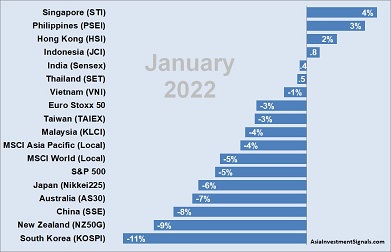 A look at the performance of the stock markets in January may give clues on how the markets could continue to develop over the next couple of months. The month of January is supposed to have some predictive power for the rest of the year. It shows how major market participants position themselves at the beginning of a year and in which markets the money flows in or out. Studies for the US market show that if January ends with a positive return, the probability that the year will end with a profit is around 90 percent. Although this statistic is valid for the US market, we can see similar effects for other stock markets.[mepr-active membership=”1734″ ifallowed=”show” unauth=”message” unauth_message=”Please login or purchase a membership to view full text.”]
A look at the performance of the stock markets in January may give clues on how the markets could continue to develop over the next couple of months. The month of January is supposed to have some predictive power for the rest of the year. It shows how major market participants position themselves at the beginning of a year and in which markets the money flows in or out. Studies for the US market show that if January ends with a positive return, the probability that the year will end with a profit is around 90 percent. Although this statistic is valid for the US market, we can see similar effects for other stock markets.[mepr-active membership=”1734″ ifallowed=”show” unauth=”message” unauth_message=”Please login or purchase a membership to view full text.”]
Since November, we have experienced a meltdown in many markets worldwide. Especially stocks, which have performed very well over the last two years and have reached high valuations lately, were the most hit. While the MSCI World and S&P500 Index lost five and more percent in January, the Asia Pacific regional index shows only a moderate loss of 3.8 percent over this first month.
However, this relatively modest loss is due to the performance of just three markets that started the new year exceptionally well, namely Singapore, the Philippines, and Hong Kong. Hong Kong was the big loser in Asia pacific last year and could potentially catch up on the lost ground. The Philippines market had to cope with a loss of 13 percent last year before a trend reversal began in August that is now continuing. After a consolidation phase lasting several months, Singapore continued the positive trend from 2020.
Nevertheless, 10 out of fourteen Asia Pacific markets we are tracking are down in January. The most substantial decline experienced China, New Zealand, and South Korea, with losses between 8 and 11 percent.
The global situation remains unpredictable currently. No one has an answer on how long the pandemic will still last, how the geopolitical threats from Russia and China will develop, and how much inflation and interest rates hikes will affect the stock markets around the world.
Many analysts remain still optimistic for the Asia Pacific region. When looking at China, the second-biggest economy has more room for monetary stimuli of its economy than most western countries have currently. China is on an easing path while the rest of the world struggles with tighter monetary policy. China’s education and internet sector faced some strict regulations last year. But these regulatory reforms may have peaked. Companies in these sectors may continue to grow by adapting to this new framework. Stocks in these areas that have fallen sharply could regain ground. Some current valuations offer attractive entry points and opportunities. On the other hand, China’s zero-Covid strategy may continue to dampen growth as it slows consumption.
We expect a volatile year ahead with improvements, not before the fourth quarter. We don’t see a significant slump at the end of the year but no significant increases either for the Asia Pacific region. Well, let’s see.
[/mepr-active]
